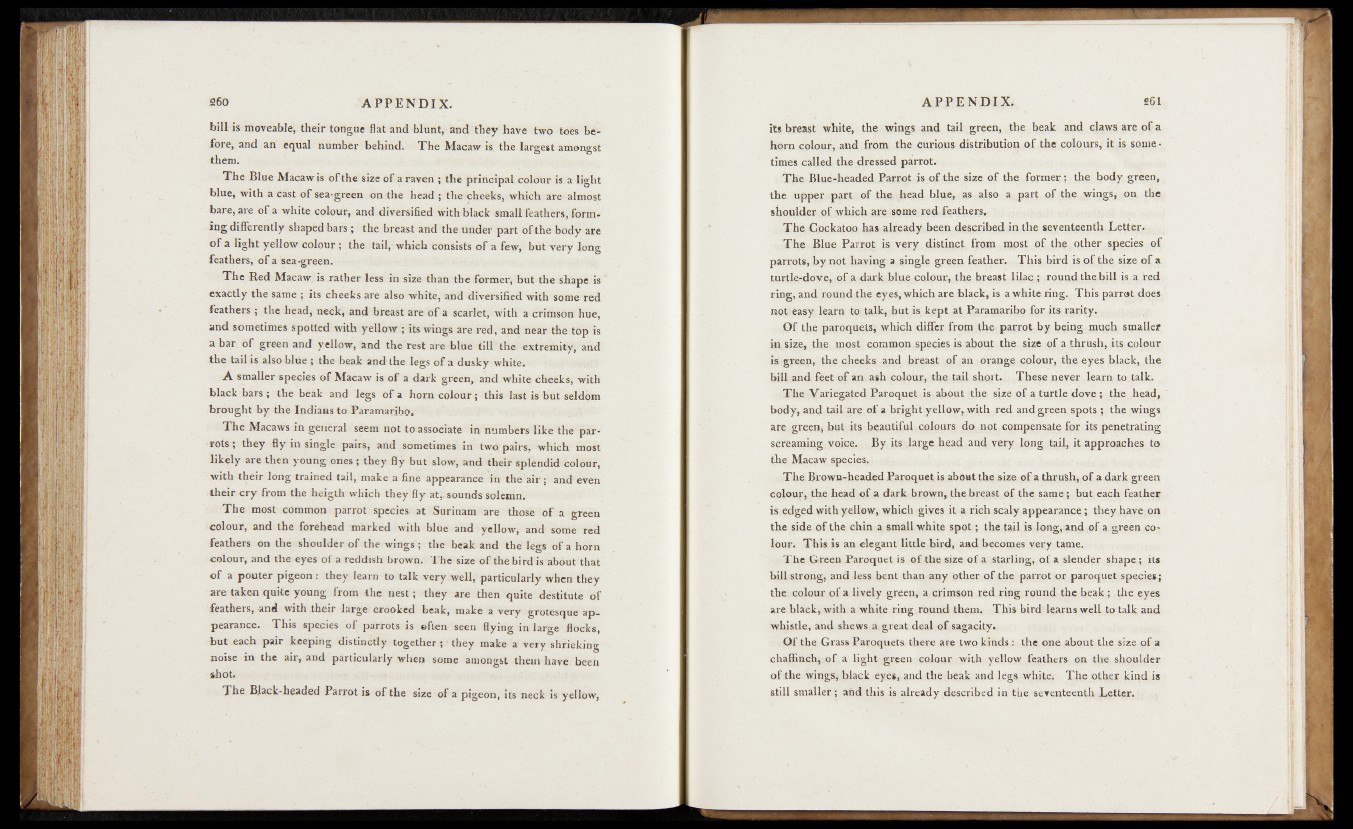
bill-is moveable, their tongue flat and blunt,-and-they have two toes before,
and an equal number behind; The Macaw is; the largest amongst
them.
The Blue Macaw is of-the size o f a raven ; the principal colour is a light
blue, with a cast o f sea-green on the head ; tbe'cheeks, which are almost
bare, are of a white colour, and diversified with black small feathers, form-
ing differently shaped bars ; the breast and the under part o f the body are
■of a light yellow colour ; the tail,which consists o f a few, but very long
feathers j o f a sea-green.
The Red Macaw, is rather less in size than the formeri but the shape is *
exactly the same ; its cheeks are also white, and diversified with some red
feathers ; the head, neck, and breast are o f a scarlet, with a crimson hue,
and sometimes spotted with yellow ; its wings are red, and near the top is
a bar o f green and yellow, and the Vest are blue till the extremity and
the tail is also blue ; the beak and the legs o f a dusky white. -
A smaller species of Macaw is o f a dark green, and white cheeks, with
black bars ; the beak and legs o f a horn colour ; this last is but seldom
brought by the Indians to Paramaribo.
The Macaws in general seem not to associate in numbers like the par-
•rots ; they fly in single pairs, and sometimes in two pairs, which most
likely are then young ones ; they fly but slow, and their splendid colour,
with their long trained tail, make a fine appearance in the air ; and even
their cry from the heigth which they fly at,-sounds solemn.
The most common parrot species at Surinam are those o f a green
colour, and the forehead marked with bine and yellow, and soirie red
feathers on thé shouldër o f the wings ; the beak and the legs of a horn
colour, and the eyes of a reddish brown. The size o f the bird is about that
o f a pouter pigeon : they learn to talk very well, particularly when they
are taken quite young from the nest ; they are then quite destitute Of
feathers, and with .their large crooked beak, maké a very grotesque appearance.
This species of parrots is ©flen seen flying in large flocks,
but -each pair keeping distinctly together ; ■ they make a very shrieking
noise in the air, and particularly when some amongst them have been
shot. ,
The Black-headed Parrot is of the size of a pigeon, its neck is yellow,
its breast white, the wings and tail green, the beak and claws are of a
horn colour, and from the curious distribution o f the colours, it,is sometimes
called the dressed parrot.
The Blue-headed Parrot is of the size o f the former: the body green,
the upper part of the head blue, as also a part o f thawings, on the
shoulder of which are some red, feathers.. .
The Cockatoo has already been described in the seventeenth Letter.
The Blue Parrot is very distinct from most of the ..other species of
parrots, by not having a single green feather. This bird is of the size of a
turtle-dove, o f a dark blue colour, the breast lilac ; round the bill is a.red
ring, and round the eyes, which are black, is a white ring. This parrot does
not easy learn to talk, but is kept at Paramaribo for its rarity.
Of the paroquets, which differ from the parrot by being much smaller
in size, the most common, species is about the size of a thrush, its colour
is green, the cheeks and breast o f an orange colour, the eyes black, the
bill and feet of an ash colour, the tail short. These never learn to talk.
The Variegated Paroquet is, about the size of a turtle dove ; the head,
body, and tail are of a bright yellow, with red and green spots ; the wings
are green, hut its beautiful colours do not compensate for its penetrating
sereaming voice. , , By its .large head and very long tail, it approaches to
the Macaw species.
The Brown-headed Paroquet is about the size of a thrush, of a dark green
colour, the head of a dark brown, the breast of the same hut each feather
is. edged with yellow, which gives it a rich scaly appearance; they have on
the side of the chin a small white sp o t; the tail is long, and of a green colour.
This is an elegant little bird, and becomes very tame.
The Green Paroquet is o f the size of a starling, of a slender shape; its
bill strong, and less bent than any other of the parrot or paroquet species;
the colour of a lively green, a. crimson red ring round the beak; the eyes
are black, with a white ring .round them. This bird; learns well to talk and
whistle, and shews a. great deal o f sagacity.
Of the Grass Paroquets there are two kinds : the one about the size of a
chaffinch, of a light, green colour with yellQw feathers on the shoulder
of .the wings, black eye#, and the beak and legs white« The other kind is
still smaller,; and this is already described in the seventeenth Letter.